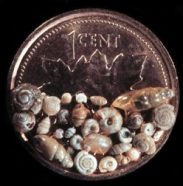Cliff snails and rock climbers
Rock climbers can accidentally wipe out communities of cliff snails.
By Emily Sohn
From Joshua Tree, California, to the White mountains of New Hampshire, good weather means one thing to the nation’s 4 million rock climbers: Time to get out and go up.
Climbers are often nature-loving people who flock to rock any chance they get. But new research suggests that even the most environmentally sensitive rock climbers may be hurting what they love most.
 |
|
Cliff-dwelling snail species, represented here by their shells.
|
| Larson/Conservation Biology |
Douglas W. Larson of the University of Guelph in Ontario, Canada, and his colleagues have been studying a popular climbing area in southern Ontario called the Niagara Escarpment, a 700-kilometer-long stretch of limestone cliffs. In a previous study, the researchers counted fewer plants and lichens growing on areas of rock that had been climbed most.
Now, Larson has found that climbers can wipe out communities of snails, too. Compared to commonly climbed routes of rock in the Niagara Escarpment, soil
collected from unclimbed areas had five times as many snail shells, Larson and colleagues report.
Snails thrive in rocky cracks and crevices. On a cliff in Wisconsin, for example, scientists found one-quarter of the state’s land-snail species in just a plate-sized area. Rock climbers probably root out snails all the time without even realizing it.
The new studies suggest that rock climbing should be more restricted and better regulated, some researchers say. “I’m amazed by the size of the effect,” says conservation biologist Menno Schilthuizen of the University of Malaysia in Sabah.
Going Deeper:
Morgan, Kendall. 2003. At a snail’s place: Rock climbing cuts mollusk diversity. Science News 162(April 12):228-229. Available at http://www.sciencenews.org/20030412/fob4.asp .







